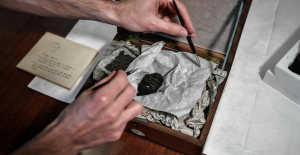“It’s Italian, Villerupt.” With its Italian film festival, this small town in Meurthe-et-Moselle perpetuates transalpine traditions in honor of immigrant ancestors. Many of them waited a long time before feeling “legitimized” in France.
“Benvenuto a Villerupt”, written in the colors of the Italian flag, replaces the Christmas lights on the roads which are starting to flourish in other towns in Lorraine. In the streets, conversations in Italian are flourishing on the sidelines of the 46th edition of Italian film, since October 27 and which ends on Sunday. “It’s a showcase for the city, but not only for the entire territory,” Pierrick Spizak, the mayor of Villerupt, explains to AFP. For two weeks, 40,000 people gathered in this small town on the border of Luxembourg and Belgium with 10,000 inhabitants, more than half of whom were Italians or descendants of Italians.
Yvo (who did not wish to give his last name), 72 years old, was born in Villerupt, where his father came after the war to work in the steel industry, like many Italians. His friends from Lorraine are also Italian, he explains: “It’s Italian, Villerupt!” He remembers, nostalgically, the 1960s, when he went to Italy by a train linking Belgium to Milan. A line which has since been closed, he regrets. “Now it would take five changes” to reach the family village by rail.
Next to the L'Arche arts center, where many films were shown for this 46th edition of the festival, a white tent houses a restaurant, where transalpine recipes are cooked by real Italian "mammas". At the start of the festival, before it brought together so many visitors, spectators even went to eat (Italian) at locals' homes. It was also at l'Arche that the jury awarded its Amilcar on Friday to director Lyda Patitucci, for the film Come pecore in mezzo ai lupi.
For this 46th edition, the programming varied from old films, with a whole retrospective in homage to director Ettore Scola (1931-2016) and the broadcast of emblematic films such as La Terrasse (1980) or Affreux, sales et villains (1976), and new releases , including the arrival of actress Jasmine Trinca and director Léa Todorov, to preview The New Woman.
“Legitimized” over time, Italian immigrants nevertheless suffered from xenophobia during their massive arrivals in France in the 19th and first half of the 20th century, recounts to AFP Piero-D Galloro, professor of sociology of migrations at the University of Lorraine. Qualified employees, capable of working underground and with tools, their skills ticked all the boxes for the need for labor in the mines or steel industry of Eastern France.
But this aroused “fear” among the French, continues the researcher, who cites in particular the novel The Invasion, by Louis Bertrand, published in 1907. The small town of Joeuf (Meurthe-et-Moselle), cradle of former French football star Michel Platini, had 170 inhabitants in 1870... and 11,000 in 1911, three-quarters of whom were foreigners, illustrates Mr. Galloro.
Then the image of Italians, seen as Europeans, Christians, improved in France, and at the same time, the descendants of immigrants wanted to reappropriate their culture. Associations for these descendants, some of whom have never seen Italy, were created in the 1970s, such as Arulef Lorena. In 1990, it had more than 400 member families, according to its secretary, Daniel Cimarelli. It organizes trips, shows, activities for children, transalpine meals... Since then, numbers have decreased and 200 families are part of it today.
The association also offered Italian lessons to children, but gradually, “it declined,” regrets Mr. Cimarelli, noting that in families, “it is often the older children who keep the tradition.” others only speak very little Italian, for example. If Italians suffered from xenophobia in France, the stigmas were “returned” towards a valorization of their culture and their traditions, explains the academic.

 B:SM will break its investment record this year with 62 million euros
B:SM will break its investment record this year with 62 million euros War in Ukraine: when kyiv attacks Russia with inflatable balloons loaded with explosives
War in Ukraine: when kyiv attacks Russia with inflatable balloons loaded with explosives United States: divided on the question of presidential immunity, the Supreme Court offers respite to Trump
United States: divided on the question of presidential immunity, the Supreme Court offers respite to Trump Maurizio Molinari: “the Scurati affair, a European injury”
Maurizio Molinari: “the Scurati affair, a European injury” Irritable bowel syndrome: the effectiveness of low-carbohydrate diets is confirmed
Irritable bowel syndrome: the effectiveness of low-carbohydrate diets is confirmed Beware of the three main sources of poisoning in children
Beware of the three main sources of poisoning in children First three cases of “native” cholera confirmed in Mayotte
First three cases of “native” cholera confirmed in Mayotte Meningitis: compulsory vaccination for babies will be extended in 2025
Meningitis: compulsory vaccination for babies will be extended in 2025 When traveling abroad, money is a source of stress for seven out of ten French people
When traveling abroad, money is a source of stress for seven out of ten French people Elon Musk arrives in China to negotiate data transfer and deployment of Tesla autopilot
Elon Musk arrives in China to negotiate data transfer and deployment of Tesla autopilot Patrick Pouyanné, CEO of TotalEnergies, is very reserved about the rapid growth of green hydrogen
Patrick Pouyanné, CEO of TotalEnergies, is very reserved about the rapid growth of green hydrogen In the United States, a Boeing 767 loses its emergency slide shortly after takeoff
In the United States, a Boeing 767 loses its emergency slide shortly after takeoff A charred papyrus from Herculaneum reveals its secrets about Plato
A charred papyrus from Herculaneum reveals its secrets about Plato The watch of the richest passenger on the Titanic sold for 1.175 million pounds at auction
The watch of the richest passenger on the Titanic sold for 1.175 million pounds at auction Youn Sun Nah: jazz with nuance and delicacy
Youn Sun Nah: jazz with nuance and delicacy Paris Globe, a new international theater festival
Paris Globe, a new international theater festival Skoda Kodiaq 2024: a 'beast' plug-in hybrid SUV
Skoda Kodiaq 2024: a 'beast' plug-in hybrid SUV Tesla launches a new Model Y with 600 km of autonomy at a "more accessible price"
Tesla launches a new Model Y with 600 km of autonomy at a "more accessible price" The 10 best-selling cars in March 2024 in Spain: sales fall due to Easter
The 10 best-selling cars in March 2024 in Spain: sales fall due to Easter A private jet company buys more than 100 flying cars
A private jet company buys more than 100 flying cars This is how housing prices have changed in Spain in the last decade
This is how housing prices have changed in Spain in the last decade The home mortgage firm drops 10% in January and interest soars to 3.46%
The home mortgage firm drops 10% in January and interest soars to 3.46% The jewel of the Rocío de Nagüeles urbanization: a dream villa in Marbella
The jewel of the Rocío de Nagüeles urbanization: a dream villa in Marbella Rental prices grow by 7.3% in February: where does it go up and where does it go down?
Rental prices grow by 7.3% in February: where does it go up and where does it go down? Even on a mission for NATO, the Charles-de-Gaulle remains under French control, Lecornu responds to Mélenchon
Even on a mission for NATO, the Charles-de-Gaulle remains under French control, Lecornu responds to Mélenchon “Deadly Europe”, “economic decline”, immigration… What to remember from Emmanuel Macron’s speech at the Sorbonne
“Deadly Europe”, “economic decline”, immigration… What to remember from Emmanuel Macron’s speech at the Sorbonne Sale of Biogaran: The Republicans write to Emmanuel Macron
Sale of Biogaran: The Republicans write to Emmanuel Macron Europeans: “All those who claim that we don’t need Europe are liars”, criticizes Bayrou
Europeans: “All those who claim that we don’t need Europe are liars”, criticizes Bayrou These French cities that will boycott the World Cup in Qatar
These French cities that will boycott the World Cup in Qatar MLS: new double for Messi who offers victory to Miami
MLS: new double for Messi who offers victory to Miami PSG-Le Havre: Ramos on his way, Kolo Muani at the bottom of the hole… Favorites and scratches
PSG-Le Havre: Ramos on his way, Kolo Muani at the bottom of the hole… Favorites and scratches Football: Vasco da Gama separates from its Argentinian coach Ramon Diaz
Football: Vasco da Gama separates from its Argentinian coach Ramon Diaz F1: for the French, Ayrton Senna is the 2nd best driver in history ahead of Prost
F1: for the French, Ayrton Senna is the 2nd best driver in history ahead of Prost

















